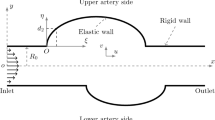Summary
We develop an automated all-hex meshing strategy for bifurcation geometries arising in subject-specific computational hemodynamics modeling. The key components of our approach are the use of a natural coordinate system, derived from solutions to Laplace’s equation, that follows the tubular vessels (arteries, veins, or grafts) and the use of a tripartitioned-based mesh topology that leads to balanced high-quality meshes in each of the branches. The method is designed for situations where the required number of hexahedral elements is relatively small (∼ 1000-4000), as is the case when spectral elements are employed in simulations at transitional Reynolds numbers or when finite elements are employed in viscous dominated regimes.
Access this chapter
Tax calculation will be finalised at checkout
Purchases are for personal use only
Preview
Unable to display preview. Download preview PDF.
Similar content being viewed by others
References
J.C. Carr, W.R. Fright, and R.K. Beatson. Surface interpolation with radial basis functions for medical imaging. IEEE Trans Med. Imaging, 16:96–107, 1997.
M.O. Deville, P.F. Fischer, and E.H. Mund. High-order methods for incompressible fluid flow. Cambridge University Press, Cambridge, 2002.
P.F. Fischer, G.W. Kruse, and F. Loth. Spectral element methods for transitional flows in complex geometries. J. Sci. Comput., 17:81–98, 2002.
[FKS+95]_M. H. Friedman, B. D. Kuban, P. Schmalbrock, K. Smith, and T. Altan. Fabrication of vascular replicas from magnetic resonance images. J. Biomech. Eng., 117:364–366, 1995.
L. Freitag and P. Plassmann. Local optimization-based simplical mesh untangling and improvement. Int. J. Numer. Methods Eng., 48:109–125, 2000.
D. N. Ku. Blood flow in arteries. Annu. Rev. Fluid Mech., 29:399–434, 1997.
[LAF+03]_F. Loth, N. Arslan, P. F. Fischer, C. D. Bertram, S. E. Lee, T. J. Royston, R. H. Song, W. E. Shaalan, and H. S. Bassiouny. Transitional flow at the venous anastomosis of an arteriovenous graft: Potential relationship with activation of the erk1/2 mechanotransduction pathway. ASME J. Biomech. Engr., 125:49–61, 2003.
W.E. Lorensen and H. E. Cline. Marching cubes: A high resolution 3d surface construction algorithm. In SIGGRAPH’ 87: Proceedings of the 14th annual conference on Computer graphics and interactive techniques, pages 163–169, New York, NY, USA, 1987. ACM Press.
S.E. Lee. Solution method for transitional flow in a vascular bifurcation based on in vivo medical images. Master’s thesis, Univ. of Illinois, Chicago, 2002. Dept. of Mechanical Engineering.
[LFL+05]_S.W. Lee, P.F. Fischer, F. Loth, T.J. Royston, J.K. Grogan, and H.S. Bassiouny. Flow-induced vein-wall vibration in an arteriovenous graft. ASME J. Fluid-Structures (to appear), 2005.
[LPL+00]_S.E. Lee, N. Piersol, F. Loth, P. Fischer, G. Leaf, Smith B., Yedevalli R., A. Yardimci, N. Alperin, and L. Schwartz. Automated mesh generation of an arterial bifurcation based upon in vivo mr images. Proceedings of the 2000 World Congress on Medical Physics and Bioengineering, CD ROM, 2000.
D.L. Marcum. Efficient generation of high quality unstructured surface and volume grids. October 2–5,2000.
T. S. Munson. Mesh shape-quality optimization using the inverse mean-ratiometric. Preprint ANL/MCS-P1136-0304, Argonne National Laboratory, Argonne, Illinois, 2004.
D. L. Marcum and N. P. Weatherill. Unstructured grid generation using iterative point insertion and local reconnction. AIAA Journal, AIAA,, 33, Num 9:1619–1625, September 1995.
Giddens D. P., C.K. Zarins, and S. Glagov. The role of fluid mechanics in the localization and detection of atherosclerosis. J. Biomech. Eng., 115:588–594, 1993.
J. Shewchuk. Delaunay Refinement Mesh Generation. PhD thesis, School of Computer Science, Carnegie Mellon University, Pittsburgh, Pennsylvania, May 1997. Available as Technical Report CMU-CS-97-137.
J. Siek and A. Lumsdaine. Generic programming for high performance numerical linear algebra.http://www.osl.iu.edu/research/mtl.
G. Taubin. A signal processing approach to fair surface design. In SIGGRAPH’ 95: Proceedings of the 22nd annual conference on Computer graphics and interactive techniques, pages 351–358, New York, NY, USA, 1995. ACM Press.
J.E. Thompson, Z.U.A. Warsi, and C. W. Mastin. Numerical Grid Generation. Elsevier Science Publisging Co., 1985.
G. Taubin, T. Zhang, and G. H. Golub. Optimal surface smoothing as filter design. In ECCV’ 96: Proceedings of the 4th European Conference on Computer Vision-Volume I, pages 283–292, London, UK, 1996. Springer-Verlag.
Author information
Authors and Affiliations
Editor information
Editors and Affiliations
Rights and permissions
Copyright information
© 2005 Springer-Verlag Berlin Heidelberg
About this paper
Cite this paper
Verma, C.S., Fischer, P.F., Lee, S.E., Loth, F. (2005). An All-Hex Meshing Strategy for Bifurcation Geometries in Vascular Flow Simulation. In: Hanks, B.W. (eds) Proceedings of the 14th International Meshing Roundtable. Springer, Berlin, Heidelberg. https://doi.org/10.1007/3-540-29090-7_22
Download citation
DOI: https://doi.org/10.1007/3-540-29090-7_22
Publisher Name: Springer, Berlin, Heidelberg
Print ISBN: 978-3-540-25137-8
Online ISBN: 978-3-540-29090-2
eBook Packages: EngineeringEngineering (R0)




